Current Trends in Fluid Viscous Dampers with Semi-Active and Adaptive Behavior
Abstract
1. Introduction
2. Passive Fluid Viscous Damper
2.1. Design Methods for FVDs in Buildings
2.2. Modeling of Passive Fluid Viscous Dampers
2.3. Passive Fluid Viscous Damper: Critical Review of Past Studies
3. Semi-Active Fluid Viscous Dampers
3.1. Rheological Fluid Viscous Dampers
3.1.1. Electrorheological Dampers
3.1.2. Magnetorheological Dampers
3.1.3. Modeling of ER and MR Dampers
3.1.4. Applications of ER and MR Dampers
3.2. Variable Orifices Fluid Viscous Dampers
3.2.1. FVDs with Solenoid Valves
3.2.2. FVDs with Servo-Valves
4. Adaptive Fluid Viscous Damper
5. Conclusions
Author Contributions
Funding
Conflicts of Interest
References
- Christopoulos, C.; Filiatrault, A. Principles of Passive Supplemental Damping and Seismic Isolation, 1st ed.; IUSS Press: Pavia, Italy, 2006. [Google Scholar]
- Zhou, L.F.; Yang, Z.; Liu, W.G.; Tan, P. New Seismic Isolation System for Irregular Structure with the Largest Isolation Building Area in the World. In Proceedings of the 13th World Conference on Earthquake Engineering, Vancouver, BC, Canada, 1–6 August 2004. [Google Scholar]
- Gandelli, E.; Quaglini, V.; Limongelli, M.P.; Capolongo, S. Seismic Isolation Retrofit of Hospital Buildings with Focus on Non-Structural Components. Ing. Sismica Int. J. Earthq. Eng. 2018, 35, 20–56. [Google Scholar]
- Kelly, J.M. The Influence of Base Isolation on the Seismic Response of Light Secondary Equipment; OSTI.GOV: Berkeley, CA, USA, 1982. [Google Scholar]
- Shi, Y.; Kurata, M.; Nakashima, M. Disorder and Damage of Base-Isolated Medical Facilities When Subjected to near-Fault and Long-Period Ground Motions. Earthq. Eng. Struct. Dyn. 2014, 43, 1683–1701. [Google Scholar] [CrossRef]
- Ariga, T.; Kanno, Y.; Takewaki, I. Resonant Behaviour of Base-Isolated High-Rise Buildings under Long-Period Ground Motions. Struct. Des. Tall Spec. Build. 2006, 15, 325–338. [Google Scholar] [CrossRef]
- Takewaki, I. Robustness of Base-Isolated High-Rise Buildings under Code-Specified Ground Motions. Struct. Des. Tall Spec. Build. 2008, 17, 257–271. [Google Scholar] [CrossRef]
- Kelly, J.M.; Skinner, R.I.; Heine, A.J. Mechanisms of Energy Absorption in Special Devices for use in Earthquake Resistant Structures. Bull. New Zealand Soc. Earthq. Eng. 1972, 5, 53–68. [Google Scholar] [CrossRef]
- Spyrakos, C.C.; Maniatakis, C.A.; Koutromanos, I.A. Soil-Structure Interaction Effects on Base-Isolated Buildings Founded on Soil Stratum. Eng. Struct. 2009, 31, 729–737. [Google Scholar] [CrossRef]
- Constantinou, M.; Kneifati, M. Dynamics of Soil-Base-Isolated-Structure Systems. J. Struct. Eng. 1988, 114, 211–221. [Google Scholar] [CrossRef]
- Spyrakos, C.C.; Koutromanos, I.A.; Maniatakis, C.A. Seismic Response of Base-Isolated Buildings Including Soil-Structure Interaction. Soil Dyn. Earthq. Eng. 2009, 29, 658–668. [Google Scholar] [CrossRef]
- Titirla, M.D. A State-of-the-Art Review of Passive Energy Dissipation Systems in Steel Braces. Buildings 2023, 13, 851. [Google Scholar] [CrossRef]
- Soong, T.T.; Spencer, B.F. Supplemental Energy Dissipation: State-of-the-Art and State-of-the-Practice. Eng. Struct. 2002, 24, 243–259. [Google Scholar] [CrossRef]
- Symans, M.D.; Constantinou, M.C. Semi-Active Control Systems for Seismic Protection of Structures: A State-of-the-Art Review. Eng. Struct. 1997, 21, 469–487. [Google Scholar] [CrossRef]
- EN 15129; Anti-Seismic Devices. CEN (European Committee for Standardization): Brussels, Belgium, 2009.
- Di Cesare, A.; Ponzo, F.C.; Lamarucciola, N.; Nigro, D. Dynamic Seismic Response of Nonlinear Displacement Dependent Devices versus Testing Required by Codes: Experimental Case Studies. Appl. Sci. 2020, 10, 8857. [Google Scholar] [CrossRef]
- Constantinou, M.C.; Symans, M.D. Experimental and Analytical Investigation of Seismic Response of Structures with Supplemental Fluid Viscous Dampers; NCEER: Buffalo, NY, USA, 1992. [Google Scholar]
- Quaglini, V.; Pettorruso, C.; Bruschi, E. Experimental and Numerical Assessment of Prestressed Lead Extrusion Dampers. Int. J. Earthq. Eng. 2021, 38, 46–69. [Google Scholar]
- Bruschi, E.; Quaglini, V. Assessment of a Novel Hysteretic Friction Damper for the Seismic Retrofit of Reinforced Concrete Frame Structures. Structures 2022, 46, 793–811. [Google Scholar] [CrossRef]
- Di Cesare, A.; Ponzo, F.C. Seismic Retrofit of Reinforced Concrete Frame Buildings with Hysteretic Bracing Systems: Design Procedure and Behaviour Factor. Shock Vib. 2017, 2017, 2639361. [Google Scholar] [CrossRef]
- Garivani, S.; Askariani, S.S.; Aghakouchak, A.A. Seismic Design of Structures with Yielding Dampers Based on Drift Demands. Structures 2020, 28, 1885–1899. [Google Scholar] [CrossRef]
- Zare Golmoghany, M.; Zahrai, S.M. Improving Seismic Behavior Using a Hybrid Control System of Friction Damper and Vertical Shear Panel in Series. Structures 2021, 31, 369–379. [Google Scholar] [CrossRef]
- Durucan, C.; Dicleli, M. Analytical Study on Seismic Retrofitting of Reinforced Concrete Buildings Using Steel Braces with Shear Link. Eng. Struct. 2010, 32, 2995–3010. [Google Scholar] [CrossRef]
- Mazza, F.; Vulcano, A. Equivalent Viscous Damping for Displacement-Based Seismic Design of Hysteretic Damped Braces for Retrofitting Framed Buildings. Bull. Earthq. Eng. 2014, 12, 2797–2819. [Google Scholar] [CrossRef]
- Yang, F.; Wang, G.; Li, M. Evaluation of the Seismic Retrofitting of Mainshock-Damaged Reinforced Concrete Frame Structure Using Steel Braces with Soft Steel Dampers. Appl. Sci. 2021, 11, 841. [Google Scholar] [CrossRef]
- Quaglini, V.; Pettorruso, C.; Bruschi, E. Design and Experimental Assessment of a Prestressed Lead Damper with Straight Shaft for Seismic Protection of Structures. Geosciences 2022, 12, 12050182. [Google Scholar] [CrossRef]
- Quaglini, V.; Bruschi, E. Controllo Passivo Mediante Controventi Dissipativi. Principi Generali, Requisiti Normativi Ed Evoluzione Dei Principali Dispositivi a Comportamento Dipendente Dallo Spostamento. Structural 2022, 240, 1–27. [Google Scholar] [CrossRef]
- Ou, J.P.; Long, X.; Li, Q.S. Seismic Response Analysis of Structures with Velocity-Dependent Dampers. J. Constr. Steel Res. 2007, 63, 628–638. [Google Scholar] [CrossRef]
- De Domenico, D.; Ricciardi, G.; Takewaki, I. Design Strategies of Viscous Dampers for Seismic Protection of Building Structures: A Review. Soil Dyn. Earthq. Eng. 2019, 118, 144–165. [Google Scholar] [CrossRef]
- Shen, D.; Kookalani, S. Effect of Fluid Viscous Damper Parameters on the Seismic Performance. J. Civ. Eng. Mater. Appl. 2020, 4, 141–153. [Google Scholar] [CrossRef]
- Taylor, D.P. History, Design and Applications of Fluid Dampers in Structural Engineering; Taylor Devices: North Tonawanda, NY, USA, 2002. [Google Scholar]
- Sorace, S. Dissipative Bracing-Based Seismic Retrofit of R/C School Buildings. Open Const. Build. Technol. J. 2012, 6, 334–345. [Google Scholar] [CrossRef]
- Taylor Devices, Inc. Fluid Viscous Dampers General Guidelines for Engineers Including a Brief History; Taylor Devices Inc.: North Tonawanda, NY, USA, 2019. [Google Scholar]
- Lago, A.; Trabucco, D.; Wood, A. Damping Technologies for Tall Buildings; Elsevier: Amsterdam, The Netherlands, 2019; ISBN 978-0-12-815963-7. [Google Scholar]
- Asher, J.W.; Young, R.P.; Ewing, R.D. Seismic Isolation Design of the San Bernardino County Medical Center Replacement Project. Struct. Des. Tall Build. 1996, 5, 265–279. [Google Scholar] [CrossRef]
- Gandelli, E.; Taras, A.; Distl, J.; Quaglini, V. Seismic Retrofit of Hospitals by Means of Hysteretic Braces: Influence on Acceleration-Sensitive Non-Structural Components. Front. Built. Environ. 2019, 5, 100. [Google Scholar] [CrossRef]
- Pecker, A. Design and Construction of the Rion Antirion Bridge. In Proceedings of the GeoTrans 2004 American Society of Civil Engineers (ASCE), Los Angeles, CA, USA, 27–31 July 2004; pp. 216–240. [Google Scholar]
- Zhou, L.; Wang, X.; Ye, A. Shake Table Test on Transverse Steel Damper Seismic System for Long Span Cable-Stayed Bridges. Eng. Struct. 2019, 179, 106–119. [Google Scholar] [CrossRef]
- Buckle, I.G. Passive Control of Structures for Seismic Loads. Bull. New Zealand Soc. Earthq. Eng. 2000, 33, 209–221. [Google Scholar] [CrossRef][Green Version]
- Spencer, B.F., Jr.; Nagarajaiah, S. State of the Art of Structural Control. J. Struct. Eng. 2003, 129, 845–856. [Google Scholar] [CrossRef]
- Spencer, B.F., Jr.; Sain, M.K. Controlling Buildings: A New Frontier in Feedback. IEEE Control Syst. 1997, 17, 19–35. [Google Scholar] [CrossRef]
- Narkhede, D.I.; Sinha, R. Full-Scale Implementation of Active Control. I: Design and Simulation. J. Struct. Eng. 1991, 117, 3516–3536. [Google Scholar]
- Xu, W.; Wang, Y.; Guo, H.; Du, D.; Wang, S. Theoretical and Experimental Investigation on the Seismic Performance of a Novel Variable-Damping Viscous Fluid Damper. J. Build. Eng. 2022, 53, 104537. [Google Scholar] [CrossRef]
- Hu, R.; Hu, S.; Yang, M.; Zhang, Y. Metallic Yielding Dampers and Fluid Viscous Dampers for Vibration Control in Civil Engineering: A Review. Int. J. Struct. Stab. Dyn. 2022, 22, 2230006. [Google Scholar] [CrossRef]
- Soong, T.T.; Spencer, B.F. Active, Semi-Active and Hybrid Control of Structures. In Proceedings of the 12th World Conference on Earthquake Engineering, Auckland, New Zealand, 30 January–4 February 2000. [Google Scholar]
- Xu, Z.-D.; Guo, Y.-Q.; Zhu, J.-T.; Xu, F.-H. Intelligent Vibration Control in Civil Engineering Structures; Elsevier Inc.: Amsterdam, The Netherlands, 2017; ISBN 9780124058743. [Google Scholar]
- Guo, T.; Xu, J.; Xu, W.; Di, Z. Seismic Upgrade of Existing Buildings with Fluid Viscous Dampers: Design Methodologies and Case Study. J. Perform. Constr. Facil. 2015, 29, 04014175. [Google Scholar] [CrossRef]
- Lee, D.; Taylor, D.P. Viscous Damper Development and Future Trends. Struct. Des. Tall Build. 2001, 10, 311–320. [Google Scholar] [CrossRef]
- Constantinou, M.C.; Symans, M.D. Experimental Study of Seismic Response of Buildings with Supplemental Fluid Dampers. Struct. Des. Tall Build. 1993, 2, 93–132. [Google Scholar] [CrossRef]
- Makris, N.; Roussos, Y.; Whittaker, A.S.; Kelly, J.M. Viscous Heating of Fluid Dampers. II: Large-Amplitude Motions. J. Eng. Mech. 1998, 124, 1217–1223. [Google Scholar] [CrossRef]
- Makris, N. Viscous Heating of Fluid Dampers. I: Small-Amplitude Motions. J. Eng. Mech. 1998, 124, 1210–1216. [Google Scholar] [CrossRef]
- He, L.; Zheng, G.T. Effect of Viscous Heating in Fluid Damper on the Vibration Isolation Performance. Mech. Syst. Signal Process. 2007, 21, 3060–3071. [Google Scholar] [CrossRef]
- Ras, A.; Boumechra, N. Study of Nonlinear Fluid Viscous Dampers Behaviour in Seismic Steel Structures Design. Arab. J. Sci. Eng. 2014, 39, 8635–8648. [Google Scholar] [CrossRef]
- Seleemah, A.A.; Constantinou, M.C. Investigation of Seismic Response of Buildings with Linear and Nonlinear Fluid Viscous Dampers; NCEER: Buffalo, NY, USA, 1997. [Google Scholar]
- Castellano, M.G.; Colato, G.P.; Infanti, S. Use of Viscous Dampers or Shock Transmission Units for Seismic Protection of Buildings. In Proceedings of the 13th World Conference on Earthquake Engineering, Vancouver, BC, Canada, 1–6 August 2004. [Google Scholar]
- Symans, M.D.; Charney, F.A.; Whittaker, A.S.; Constantinou, M.C.; Kircher, C.A.; Johnson, M.W.; McNamara, R.J. Energy Dissipation Systems for Seismic Applications: Current Practice and Recent Developments. J. Struct. Eng. 2008, 134, 3–21. [Google Scholar] [CrossRef]
- Antonucci, R.; Balducci, F.; Bartera, F.; Castellano, M.; Fuller, K.; Giacchetti, R. Shaking Table Testing of an RC Frame with Dissipative Bracings. In Proceedings of the 13th World Conference on Earthquake Engineering, Vancouver, BC, Canada, 1–6 August 2004. [Google Scholar]
- Şigaher, A.N.; Constantinou, M.C. Scissor-Jack-Damper Energy Dissipation System. Earthq. Spectra 2003, 19, 133–158. [Google Scholar] [CrossRef]
- NTC2018; Technical Standards on Constructions. Italian Council of Public Works: Rome, Italy, 2018; Volume 20.
- Bruschi, E.; Quaglini, V.; Zoccolini, L. Seismic Upgrade of Steel Frame Buildings by Using Damped Braces. Appl. Sci. 2023, 13, 2063. [Google Scholar] [CrossRef]
- Bruschi, E.; Zoccolini, L.; Cattaneo, S.; Quaglini, V. Experimental Characterization, Modeling, and Numerical Evaluation of a Novel Friction Damper for the Seismic Upgrade of Existing Buildings. Materials 2023, 16, 1933. [Google Scholar] [CrossRef]
- Palermo, M.; Silvestri, S.; Landi, L.; Gasparini, G.; Trombetti, T. A “Direct Five-Step Procedure” for the Preliminary Seismic Design of Buildings with Added Viscous Dampers. Eng. Struct. 2018, 173, 933–950. [Google Scholar] [CrossRef]
- Silvestri, S.; Gasparini, G.; Trombetti, T. A Five-Step Procedure for the Dimensioning of Viscous Dampers to Be Inserted in Building Structures. J. Earthq. Eng. 2010, 14, 417–447. [Google Scholar] [CrossRef]
- Lin, Y.Y.; Tsai, M.H.; Hwang, J.S.; Chang, K.C. Direct Displacement-Based Design for Building with Passive Energy Dissipation Systems. Eng. Struct. 2003, 25, 25–37. [Google Scholar] [CrossRef]
- Lin, Y.Y.; Chang, K.C.; Chen, C.Y. Direct Displacement-Based Design for Seismic Retrofit of Existing Buildings Using Nonlinear Viscous Dampers. Bull. Earthq. Eng. 2008, 6, 535–552. [Google Scholar] [CrossRef]
- Sullivan, T.J.; Lago, A. Towards a Simplified Direct DBD Procedure for the Seismic Design of Moment Resisting Frames with Viscous Dampers. Eng. Struct. 2012, 35, 140–148. [Google Scholar] [CrossRef]
- Terenzi, G. Energy-Based Design Criterion of Dissipative Bracing Systems for the Seismic Retrofit of Frame Structures. Appl. Sci. 2018, 8, 268. [Google Scholar] [CrossRef]
- Sorace, S.; Terenzi, G. Seismic Protection of Frame Structures by Fluid Viscous Damped Braces. J. Struct. Eng. 2008, 134, 45–55. [Google Scholar] [CrossRef]
- Hareen, C.H.B.V.; Mohan, S.C. Energy-Based Seismic Retrofit and Design of Building Frames with Passive Dampers. Eng. Struct. 2022, 250, 113412. [Google Scholar] [CrossRef]
- Hallauer, W.L. Introduction to Linear Time-Invariant Dynamic System for Students of Engineering; Virginia Tech: Blacksburg, VA, USA, 2022. [Google Scholar]
- Conde, J.; Bernabeu, A. Influence of Maxwell Stiffness in Damage Control and Analysis of Structures with Added Viscous Dampers. Appl. Sci. 2021, 11, 3089. [Google Scholar] [CrossRef]
- Kasai, K.; Ooki, Y.; Ito, H.; Motoyui, S.; Ozaki, H.; Ishii, M.; Kajiwara, K.; Hikino, T. Full-Scale E-Defense Shake Table Tests on 5-Storey Steel Building with Various Damper. In Proceedings of the 9th U.S. National and 10th Canadian Conference on Earthquake Engineering, Toronto, ON, Canada, 25 June 2010. [Google Scholar]
- Dong, B.; Sause, R.; Ricles, J.M. Seismic Response and Performance of a Steel MRF Building with Nonlinear Viscous Dampers under DBE and MCE. J. Struct. Eng. 2016, 142, 04016023. [Google Scholar] [CrossRef]
- Symans, M.D.; Constantinou, M.C. Passive Fluid Viscous Damping System for Seismic Energy Dissipation. J. Earthq. Technol. 1992, 34, 185–206. [Google Scholar]
- Mokhtari, M.; Naderpour, H. Seismic Vulnerability Assessment of Reinforced Concrete Buildings Having Nonlinear Fluid Viscous Dampers. Bull. Earthq. Eng. 2022, 20, 7675–7704. [Google Scholar] [CrossRef]
- Scozzese, F.; Gioiella, L.; Dall’Asta, A.; Ragni, L.; Tubaldi, E. Influence of Viscous Dampers Ultimate Capacity on the Seismic Reliability of Building Structures. Struct. Saf. 2021, 91, 102096. [Google Scholar] [CrossRef]
- Sorace, S.; Terenzi, G. Fluid Viscous Damper-Based Seismic Retrofit Strategies of Steel Structures: General Concepts and Design. Adv. Steel Constr. 2008, 5, 322–339. [Google Scholar]
- Greco, R.; Marano, G.C. Identification of Parameters of Maxwell and Kelvin-Voigt Generalized Models for Fluid Viscous Dampers. J. Vib. Control 2015, 21, 260–274. [Google Scholar] [CrossRef]
- Makris, N.; Constantinou, M.C. Fractional-Derivative Maxwell Model for Viscous Dampers. J. Struct. Eng. 1991, 117, 2708–2724. [Google Scholar] [CrossRef]
- CSPFEA. MidasGen, CSPFEA Engineering Solutions. 2018. Available online: https://www.cspfea.net/prodotti/midas-gen/ (accessed on 1 July 2023).
- Brunetta, M.; Bandini, L.; De Lorenzi, M. SAP2000, Analisi Lineare/Nonlineare Integrata Con Verifiche per Strutture Tridimensionali; CSI Computer and Structures Inc.: Walnut Creek, CA, USA, 2006. [Google Scholar]
- Bird, R.B.; Armstrong, R.P.; Ewing, R.D. Dynamics of Polymer Liquids; Wiley and Sons: New York, NY, USA, 1987; Volume 1. [Google Scholar]
- Narkhede, D.I.; Sinha, R. Behavior of Nonlinear Fluid Viscous Dampers for Control of Shock Vibrations. J. Sound Vib. 2014, 333, 80–98. [Google Scholar] [CrossRef]
- Serra-Aguila, A.; Puigoriol-Forcada, J.M.; Reyes, G.; Menacho, J. Viscoelastic Models Revisited: Characteristics and Interconversion Formulas for Generalized Kelvin–Voigt and Maxwell Models. Acta Mech. Sin. 2019, 35, 1191–1209. [Google Scholar] [CrossRef]
- Constantinou, M.C.; Symans, M.D. Seismic Response of Structures with Supplemental Damping. Struct. Des. Tall Build. 1993, 2, 77–92. [Google Scholar] [CrossRef]
- Silvestri, S.; Trombetti, T. Physical and Numerical Approaches for the Optimal Insertion of Seismic Viscous Dampers in Shear-Type Structures. J. Earthq. Eng. 2007, 11, 787–828. [Google Scholar] [CrossRef]
- Wang, S.; Mahin, S.A. Seismic Retrofit of a High-Rise Steel Moment-Resisting Frame Using Fluid Viscous Dampers. Struct. Des. Tall Spec. Build. 2017, 26, e1367. [Google Scholar] [CrossRef]
- Miani, M.; Di Marco, C.; Frappa, G.; Pauletta, M. Effects of Dissipative Systems on the Seismic Behavior of Irregular Buildings—Two Case Studies. Buildings 2020, 10, 202. [Google Scholar] [CrossRef]
- Taylor Devices Inc. Standing Tall, Taylor Solutions for High-Rise Structures. Available online: www.taylordevices.com/custom/pdf/brochures/StandingTall-HighriseBrochure.pdf (accessed on 1 July 2023).
- Miyamoto, K.; Gilani, A.S.J.; Glasgow, R.S. Seismic Retrofit of a Hospital Building with Supplementary Damping Devices. In Proceedings of the New Horizons and Better Practices, Long Beach, CA, USA, 16–19 May 2007. [Google Scholar]
- Guo, T.; Asce, M.; Liu, J.; Zhang, Y.; Pan, S. Displacement Monitoring and Analysis of Expansion Joints of Long-Span Steel Bridges with Viscous Dampers. J. Bridge Eng. 2015, 20, 04014099. [Google Scholar] [CrossRef]
- Infanti, S.; Kang, H.; Castellano, M. Retrofit of Bridges in Korea Using Viscous Damper Technology. In Proceedings of the 13th World Conference on Earthquake Engineering, Vancouver, BC, Canada, 1–6 August 2004. [Google Scholar]
- Infanti, S.; Papanikolas, P.; Benzoni, G.; Castellano, M.G. Rion-Antirion Bridge: Design and Full-Scale Testing of the Seismic Protection Device. In Proceedings of the 13th World Conference on Earthquake Engineering, Vancouver, BC, Canada, 1–6 August 2004. [Google Scholar]
- Troung, D.Q.; Ahn, K.K. MR Fluid Damper and Its Application to Force Sensorless Damping Control System. In Smart Actuation and Sensing Systems—Recent Advances and Future Challenges; Intechopen: London, UK, 2012; pp. 383–424. [Google Scholar]
- Housner, G.W.; Bergman, L.A.; Caughey, T.K.; Chassiakos, A.G.; Claus, R.O.; Masri, S.F.; Skelton, R.E.; Soong, T.T.; Member, S.; Spencer, B.F.; et al. Structural Control: Past, Present, and Future. J. Eng. Mech. 1997, 123, 897–971. [Google Scholar] [CrossRef]
- Hu, G.; Yi, F.; Liu, H.; Zeng, L. Performance Analysis of a Novel Magnetorheological Damper with Displacement Self-Sensing and Energy Harvesting Capability. J. Vib. Eng. Technol. 2021, 9, 85–103. [Google Scholar] [CrossRef]
- Chen, Z.H.; Lam, K.H.; Ni, Y.Q. Enhanced Damping for Bridge Cables Using a Self-Sensing MR Damper. Smart Mater. Struct. 2016, 25, 085019. [Google Scholar] [CrossRef]
- Lam, K.H.; Chen, Z.H.; Ni, Y.Q.; Chan, H.L.W. A Magnetorheological Damper Capable of Force and Displacement Sensing. Sens. Actuators. A Phys. 2010, 158, 51–59. [Google Scholar] [CrossRef]
- Ghaffarzadeh, H.; Dehrod, E.A.; Talebian, N. Semi-Active Fuzzy Control for Seismic Response Reduction of Building Frames Using Variable Orifice Dampers Subjected to near-Fault Earthquakes. J. Vib. Control 2013, 19, 1980–1998. [Google Scholar] [CrossRef]
- Xu, Y.L.; Qu, W.L.; Ko, J.M. Seismic Response Control of Frame Structures Using Magnetorheological/Electrorheological Dampers. Earthq. Eng. Struct. Dyn. 2000, 29, 557–575. [Google Scholar] [CrossRef]
- Dyke, S.J.; Spencer, B.F. Comparison of Semi-Active Control Strategies for the MR Damper. In Proceedings of the International Conference on Intelligent Information Systems, Nassau, Bahamas, 8 December 1997. [Google Scholar]
- Hiemenz, G.J.; Choi, Y.-T.; Wereley, N.M. Seismic Control of Civil Structures Utilizing Semi-Active MR Bracing Systems. In Proceedings of the SPIE Smart Structures and Materials 2000: Smart Systems for Bridges, Structures, and Highways, Newport Beach, CA, USA, 6 March 2000; Volume 3988, pp. 217–228. [Google Scholar]
- Choi, K.M.; Cho, S.W.; Jung, H.J.; Lee, I.W. Semi-Active Fuzzy Control for Seismic Response Reduction Using Magnetorheological Dampers. Earthq. Eng. Struct. Dyn. 2004, 33, 723–736. [Google Scholar] [CrossRef]
- Pourzeynali, S.; Lavasani, H.H.; Modarayi, A.H. Active Control of High Rise Building Structures Using Fuzzy Logic and Genetic Algorithms. Eng. Struct. 2007, 29, 346–357. [Google Scholar] [CrossRef]
- Shiraishi, T.; Nakaya, N.; Morishita, S.; Schoot, G. Structural Control by a Variable Damper Using MR Fluid. In Proceedings of the 6th International Conference on Motion and Vibration Control, Saitama, Japan, 19 August 2002; pp. 24–29. [Google Scholar]
- Yi, F.; Dyke, S.J.; Caicedo, J.M.; Carlson, J.D. Experimental Verification of Multiinput Seismic Control Strategies for Smart Dampers. J. Eng. Mech. 2001, 127, 1152–1164. [Google Scholar] [CrossRef]
- Symans, M.D.; Constantinou, M.C. Development and Experimental Study of Semi-Active Fluid Damping Devices for Seismic Protection of Structures; NCEER: Buffalo, NY, USA, 1995. [Google Scholar]
- Dyke, S.J.; Spencer, B.F.; Saint, M.K.; Carison, J.D. Seismic Response Reduction Using Magnetorheological Dampers. In Proceedings of the IFAC World Congress, Heidelberg, Germany, 25–29 September 1956; pp. 145–150. [Google Scholar]
- Davis, L.C. Polarization Forces and Conductivity Effects in Electrorheological Fluids. J. Appl. Phys. 1992, 72, 1334–1340. [Google Scholar] [CrossRef]
- Wen, W.; Huang, X.; Sheng, P. Electrorheological Fluids: Structures and Mechanisms. Soft Matter 2008, 4, 200. [Google Scholar] [CrossRef]
- Goncalves, F.D.; Carlson, J.D. An Alternate Operation Mode for MR Fluids—Magnetic Gradient Pinch. J. Phys. Conf. Ser. 2009, 149, 012050. [Google Scholar] [CrossRef]
- Chopra, I.; Sirohi, J. Electrorheological and Magnetorheological Fluids. In Smart Structures Theory; Cambridge University Press: Cambridge, UK, 2013; pp. 685–738. [Google Scholar]
- Stanway, R. Smart Fluids: Current and Future Developments. Mater. Sci. Technol. 2004, 20, 931–939. [Google Scholar] [CrossRef]
- Dassisti, M.; Brunetti, G. Introduction to Magnetorheological Fluids. In Encyclopedia of Smart Materials; Elsevier: Amsterdam, The Netherlands, 2021; pp. 187–202. ISBN 9780128157336. [Google Scholar]
- Mäkelä, K.K. Characterization and Performance of Electrorheological Fluids Based on Pine Oils. J. Intell. Mater. Syst. Struct. 1999, 10, 609–614. [Google Scholar] [CrossRef]
- Chen, K.; Tian, Y.; Shan, L.; Jiang, J. Transient Response of Sheared Magnetic Powder Excited by a Stepwise Magnetic Field and Its Comparison with ER and MR Fluids. Smart Mater. Struct. 2013, 22, 097001. [Google Scholar] [CrossRef]
- Winslow, W.M. Method and Means for Translating Electrical Impulses into Mechanical Force. U.S. Patent 2417850A, 25 March 1947. [Google Scholar]
- Makris, N.; Burton, S.A.; Hill, D.; Jordan, M. Analysis and Design of ER Damper for Seismic Protection of Structures. J. Eng. Mech. 1996, 122, 1003–1011. [Google Scholar] [CrossRef]
- Rosenfeld, N.; Wereley, N.M.; Radakrishnan, R.; Sudarshan, T.S. Behavior of Magnetorheological Fluids Utilizing Nanopowder Iron. Int. J. Mod. Phys. B 2002, 16, 2392–2398. [Google Scholar] [CrossRef]
- Deng, H.; Lian, X.; Gong, X. A Brief Review of Variable Stiffness and Damping Magnetorheological Fluid Dampers. Front. Mater. 2022, 9, 1019426. [Google Scholar] [CrossRef]
- Mao, M.; Choi, Y.T.; Wereley, N.M. Effective Design Strategy for a Magneto-Rheological Damper Using a Nonlinear Flow Model. In Proceedings of the SPIE Smart Structures and Materials 2005: Damping and Isolation, San Diego, CA, USA, 7–10 March 2005; Volume 5760, pp. 446–455. [Google Scholar]
- Daniel, C.; Hemalatha, G.; Magdalene, A.; Tensing, D.; Sundar Manoharan, S. Magnetorheological Damper for Performance Enhancement Against Seismic Forces. In Sustainable Civil Infrastructures; Springer Science and Business Media B.V.: Berlin/Heidelberg, Germany, 2018; pp. 104–117. [Google Scholar]
- Kori, J.G.; Jangid, R.S. Semi-Active Stiffness Dampers for Seismic Control of Structures. Adv. Struct. Eng. 2007, 10, 501–524. [Google Scholar] [CrossRef]
- Yoshida, O.; Dyke, S.J. Seismic Control of a Nonlinear Benchmark Building Using Smart Dampers. J. Eng. Mech. 2004, 130, 363–530. [Google Scholar] [CrossRef]
- Dyke, S.J.; Spencer, F.; Sain, M.K.; Carlson, J.D. Modeling and Control of Magnetorheological Dampers for Seismic Response Reduction. Smart Mater. Struct. 1996, 5, 565–575. [Google Scholar] [CrossRef]
- Ahn, K.K.; Truong, D.Q.; Islam, M.A. Modeling of a Magneto-Rheological (MR) Fluid Damper Using a Self Tuning Fuzzy Mechanism. J. Mech. Sci. Technol. 2009, 23, 1485–1499. [Google Scholar] [CrossRef]
- Soltane, S.; Montassar, S.; Mekki, O.B.; Fatmi, R. El A Hysteretic Bingham Model for MR Dampers to Control Cable Vibrations. J. Mech. Mater. Struct. 2015, 10, 195–206. [Google Scholar] [CrossRef]
- Kamath, G.M.; Hurt, M.K.; Wereley, N.M. Analysis and Testing of Bingham Plastic Behavior in Semi-Active Electrorheological Fluid Dampers. Smart Mater. Struct. 1996, 5, 576–590. [Google Scholar] [CrossRef]
- Spencer, B.F., Jr.; Dyke, S.J.; Sain, M.K.; Carlson, J.D. Phenomenological Model for Magnetorheological Dampers. J. Eng. Mech. 1997, 123, 230–238. [Google Scholar] [CrossRef]
- Abdul Aziz, M.; Muhtasim, S.; Ahammed, R. State-of-the-Art Recent Developments of Large Magnetorheological (MR) Dampers: A Review. Korea Aust. Rheol. J. 2022, 34, 105–136. [Google Scholar] [CrossRef]
- Weber, F. Bouc-Wen Model-Based Real-Time Force Tracking Scheme for MR Dampers. Smart Mater. Struct. 2013, 22, 045012. [Google Scholar] [CrossRef]
- Kwok, N.M.; Ha, Q.P.; Nguyen, M.T.; Li, J.; Samali, B. Bouc-Wen Model Parameter Identification for a MR Fluid Damper Using Computationally Efficient GA. ISA Trans. 2007, 46, 167–179. [Google Scholar] [CrossRef]
- Solovyov, A.M.; Semenov, M.E.; Meleshenko, P.A.; Barsukov, A.I. Bouc-Wen Model of Hysteretic Damping. Procedia Eng. 2017, 201, 549–555. [Google Scholar] [CrossRef]
- Lenggana, B.W.; Ubaidillah, U.; Imaduddin, F.; Choi, S.B.; Purwana, Y.M.; Harjana, H. Review of Magnetorheological Damping Systems on a Seismic Building. Appl. Sci. 2021, 11, 9339. [Google Scholar] [CrossRef]
- Bouc, R. A Mathematical Model for Hysteresis. Acta Acust. United Acust. 1971, 24, 16–25. [Google Scholar]
- Wen, Y.K. Method for Random Vibration of Hysteretic Systems. J. Eng. Mech. Div. 1976, 102, 249–263. [Google Scholar] [CrossRef]
- Choi, S.B.; Nam, M.H.; Lee, B.K. Vibration Control of a MR Seat Damper for Commercial Vehicles. J. Intell. Mater. Syst. Struct. 2001, 11, 936–944. [Google Scholar] [CrossRef]
- Spelta, C.; Previdi, F.; Savaresi, S.M.; Fraternale, G.; Gaudiano, N. Control of Magnetorheological Dampers for Vibration Reduction in a Washing Machine. Mechatronics 2009, 19, 410–421. [Google Scholar] [CrossRef]
- Kim, H.C.; Shin, Y.J.; You, W.; Jung, K.C.; Oh, J.S.; Choi, S.B. A Ride Quality Evaluation of a Semi-Active Railway Vehicle Suspension System with MR Damper: Railway Field Tests. Proc. Inst. Mech. Eng. F J. Rail Rapid Transit 2017, 231, 306–316. [Google Scholar] [CrossRef]
- Lau, Y.K.; Liao, W.H. Design and Analysis of Magnetorheological Dampers for Train Suspension. Proc. Inst. Mech. Eng. F J. Rail Rapid Transit 2005, 219, 261–276. [Google Scholar] [CrossRef]
- Huang, H.; Sun, S.; Chen, S.; Li, W. Numerical and Experimental Studies on a New Variable Stiffness and Damping Magnetorheological Fluid Damper. J. Intell. Mater. Syst. Struct. 2019, 30, 1639–1652. [Google Scholar] [CrossRef]
- Lee, D.Y.; Nam, Y.J.; Yamane, R.; Park, M.K. Performance Evaluation on Vibration Control of MR Landing Gear. J. Phys. Conf. Ser. 2009, 149, 012068. [Google Scholar] [CrossRef]
- Wereley, N.M.; Hu, W.; Kother, C.S.; Chen, P.C.; Ngatu, G.T. Magnetorheological Fluid Elastic Lag Damper for Helicopter Rotors. U.S. Patent 8413772B2, 9 April 2013. [Google Scholar]
- Ubaidillah, U.; Lenggana, B.W.; Son, L.; Imaduddin, F.; Widodo, P.J.; Harjana, H.; Doewes, R.I. A New Magnetorheological Fluids Damper for Unmanned Aerial Vehicles. J. Adv. Res. Fluid Mech. Ther. Sci. 2020, 73, 35–45. [Google Scholar] [CrossRef]
- Gordaninejad, F.; Wang, X.; Hitchcock, G.; Bangrakulur, K.; Ruan, S.; Siino, M. Modular High-Force Seismic Magneto-Rheological Fluid Damper. J. Struc. Eng. 2010, 136, 135–143. [Google Scholar] [CrossRef]
- Wangsa Lenggana, B.; Imaduddin, F.; Dwi Purnomo, E.; Utami, D.; Amri Mazlan, S. Performance Prediction of a Novel Modular Magnetorheological Damper for Seismic Building. J. Adv. Res. Fluid Mech. Ther. Sci. 2019, 58, 275–286. [Google Scholar]
- Sodeyama, H.; Suzuki, K.; Sunakoda, K. Development of Large Capacity Semi-Active Seismic Damper Using Magneto-Rheological Fluid. J. Press. Vessel Technol. 2004, 126, 105–109. [Google Scholar] [CrossRef]
- Chen, Z.Q.; Wang, X.Y.; Ko, J.M.; Ni, Y.Q.; Spencer, B.F.; Yang, G. MR Damping System on Dongting Lake Cable-Stayed Bridge. Smart Struct. Mater. 2003, 5057, 229–235. [Google Scholar]
- Zhao, J.; Cao, X.; Jing, Y.; Chen, X.; Bai, R.; Yi, J.; Luo, J.; Pu, H. Numerical and Experimental Study of a Novel GER Fluid Damper Based on Helical Duct Flow. Smart Mater. Struct. 2022, 31, 125024. [Google Scholar] [CrossRef]
- Wen, W.; Huang, X.; Yang, S.; Lu, K.; Sheng, P. The Giant Electrorheological Effect in Suspensions of Nanoparticles. Nat. Mater. 2003, 2, 727–730. [Google Scholar] [CrossRef]
- Wen, W.; Huang, X.; Sheng, P. Particle Size Scaling of the Giant Electrorheological Effect. Appl. Phys. Lett. 2004, 85, 299–301. [Google Scholar] [CrossRef]
- Xu, Z.; Hong, Y.; Zhang, M.; Wu, J.; Wen, W. Performance Tuning of Giant Electrorheological Fluids by Interfacial Tailoring. Soft Matter 2018, 14, 1427–1433. [Google Scholar] [CrossRef]
- Sun, Y.; Huang, Y.; Wang, M.; Wu, J.; Yuan, S.; Ding, J.H.; Peng, Y.; Pu, H.; Xie, S.; Luo, J. Design, Testing and Modelling of a Tuneable GER Fluid Damper under Shear Mode. Smart Mater. Struct. 2020, 29, 085011. [Google Scholar] [CrossRef]
- Pu, H.; Huang, Y.; Sun, Y.; Wang, M.; Yuan, S.; Kong, Z.; Yang, P.; Chu, L.; Wu, J.; Peng, Y.; et al. Design and Experiment of Bio-Inspired GER Fluid Damper. Sci. China Inf. Sci. 2020, 63, 1–3. [Google Scholar] [CrossRef]
- Javanmardi, A.; Ghaedi, K.; Huang, F.; Hanif, M.U.; Tabrizikahou, A. Application of Structural Control Systems for the Cables of Cable-Stayed Bridges: State-of-the-Art and State-of-the-Practice. Arch. Comput. Methods Eng. 2022, 29, 1611–1641. [Google Scholar] [CrossRef]
- Kobori, T.; Takahashi, M.; Nasu, T.; Niwa, N. Seismic Response Controlled Structure with Active Variable Stiffness System. Earthq. Eng. Struct. Dyn. 1993, 22, 925–941. [Google Scholar] [CrossRef]
- He, W.L.; Agrawal, A.K.; Mahmoud, K. Control of Seismically Excited Cable-Stayed Bridge Using Resetting Semiactive Stiffness Dampers. J. Bridge Eng. 2001, 6, 376–384. [Google Scholar] [CrossRef]
- Luca, S.; Pastia, C. Case Study of Variable Orifice Damper for Seismic Protection of Structures. Bul. Institutului Politeh. Din Lasi. Sect. Constr. Arhit. 2009, 55, 39. [Google Scholar]
- Symans, M.D.; Constantinou, M.C.; Taylor, D.P.; Garnjost, K.D. Semi-Active Fluid Viscous Dampers for Seismic Response Control. In Proceedings of the 1st World Conference of Structrual Control, Los Angeles, CA, USA, 3–5 August 1994; pp. 3–12. [Google Scholar]
- Symans, M.D.; Constantinou, M.C. Seismic Testing of a Building Structure with a Semi-Active Fluid Damper Control System. Earthq. Eng. Struct. Dyn. 1997, 26, 759–777. [Google Scholar] [CrossRef]
- Kawashima, K.; Unjoh, S.; Shimizu, H. Seismic Response Control of Highway Bridges by Variable Damper. In Proceedings of the 24th Joint Meeting on Wind and Seismic Effects, Washington, DC, USA, September 1992; p. 7184. [Google Scholar]
- Kawashima, K.; Unjoh, S. Seismic Response Control of bridges by Variable Dampers. J. Struct. Eng. 1994, 120, 2583–2601. [Google Scholar] [CrossRef]
- Patten, W.N.; Sack, R.L.; He, Q. Controlled Semiactive Hydraulic Absorber for Bridges. J. Struct. Eng. 1996, 122, 187–192. [Google Scholar] [CrossRef]
- Niwa, N.; Koboris, T.; Takahashi, M.; Midorikawa, H.; Kuratar, N.; Mizuno, T. Dynamic Loading Test and Simulation Analysis of Full-Scale Semi-Active Hydraulic Damper for Structural Control. Earthq. Eng. Struct. Dyn. 2000, 29, 789–812. [Google Scholar] [CrossRef]
- Shmerling, A.; Gerdts, M. Short-Horizon Acceleration-Predictive Control for Reducing Lateral Seismic Inertia Forces of Inelastic Frame Structures Using Semi-Active Fluid Viscous Dampers. Comput. Struct. 2023, 281, 107032. [Google Scholar] [CrossRef]
- Javadinasab Hormozabad, S.; Zahrai, S.M. Innovative Adaptive Viscous Damper to Improve Seismic Control of Structures. Vib. Control 2019, 25, 1833–1851. [Google Scholar] [CrossRef]
- Eyres, R.D.; Champneys, A.R.; Lieven, N.A.J. Modelling and Dynamic Response of a Damper with Relief Valve. Nonlinear Dyn. 2005, 40, 119–147. [Google Scholar] [CrossRef]
- Eyres, R.D.; Piiroinen, P.T.; Champneys, A.R.; Lieven, N.A.J. Grazing Bifurcations and Chaos in the Dynamics of a Hydraulic Damper with Relief Valves. J. Appl. Dyn. Syst. 2005, 4, 1076–1106. [Google Scholar] [CrossRef][Green Version]
- Bauchau, O.A.; Liu, H. On the Modeling of Hydraulic Components in Rotorcraft Systems. J. Am. Helicopter Soc. 2006, 51, 175–184. [Google Scholar] [CrossRef]
- Bottasso, C.L.; Cacciola, S.; Croce, A.; Dozio, L. Load Reduction in Lead-Lag Dampers by Speed-Scheduled Aperture and Modulated Control of a Bypass Valve. J. Am. Helicopter Soc. 2012, 57, 16–28. [Google Scholar] [CrossRef]
- Sakakibara, K. KYB Technical Review. October 2017. pp. 43–47. Available online: https://www.kyb.co.jp/english/technical_report/data/no55e/all.pdf (accessed on 6 August 2023).
- KYB. About Nonconforming Acts in the Inspection Process, etc. for Seismic Isolation/Mitigation Oil Dampers for Buildings Manufactured by Us and Our Subsidiary. 2018. Available online: http://www.kyb.co.jp/english (accessed on 1 July 2023).
- Hazaveh, N.; Rodgers, G.W.; Pampanin, S.; Chase, J.G. Damping Reduction Factors and Code-Based Design Equation for Structures Using Semi-Active Viscous Dampers. Earthq. Eng. Struct. Dyn. 2016, 45, 2533–2550. [Google Scholar] [CrossRef]
- Hazaveh, N.K.; Rodgers, G.W.; Chase, J.G.; Pampanin, S. Reshaping Structural Hysteresis Response with Semi-Active Viscous Damping. Bull. Earthq. Eng. 2017, 15, 1789–1806. [Google Scholar] [CrossRef]
- Hazaveh, N.K.; Rodgers, G.W.; Chase, J.G.; Pampanin, S. Experimental Test and Validation of a Direction- and Displacement-Dependent Viscous Damper. J. Eng. Mech. 2017, 143, 04017132. [Google Scholar] [CrossRef]
- Hazaveh, N.K.; Chase, J.G.; Rodgers, G.W.; Pampanin, S.; Kordani, R. Seismic Behavior of a Self-Centering System with 2–4 Viscous Damper. J. Earthq. Eng. 2020, 24, 470–484. [Google Scholar] [CrossRef]

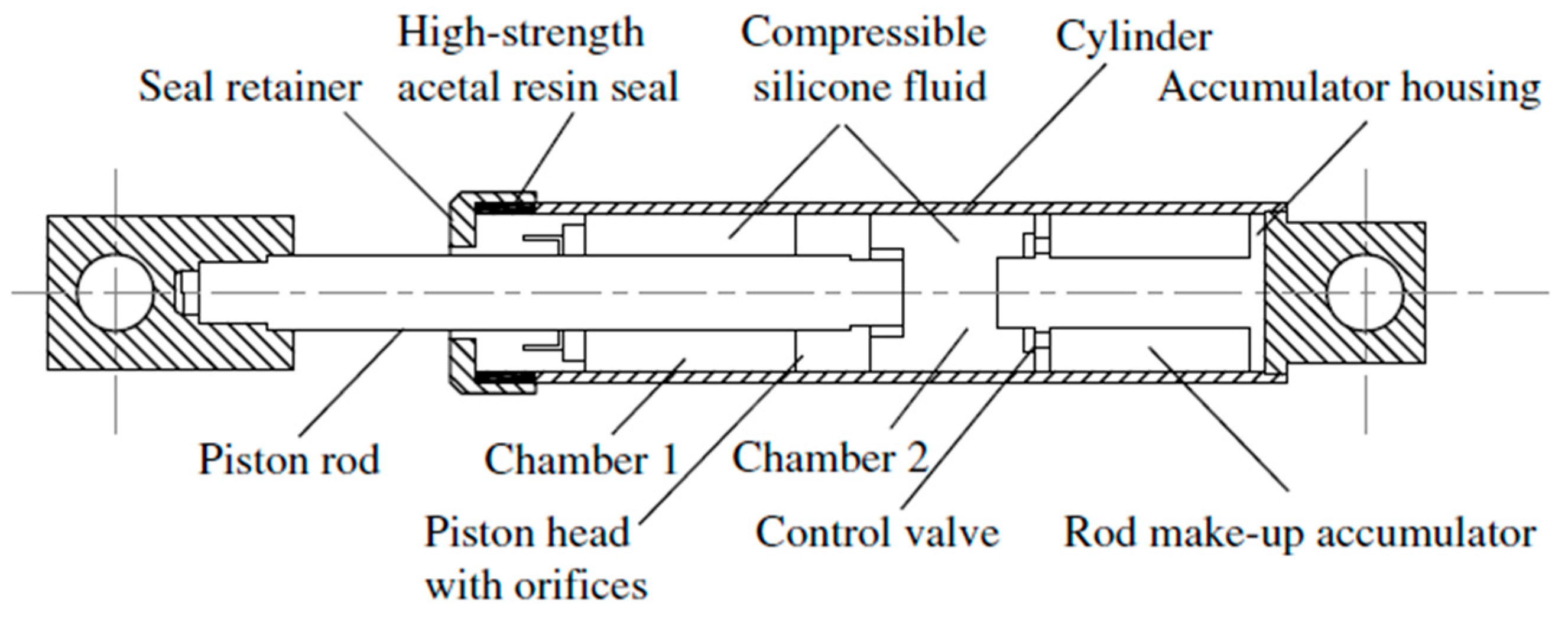

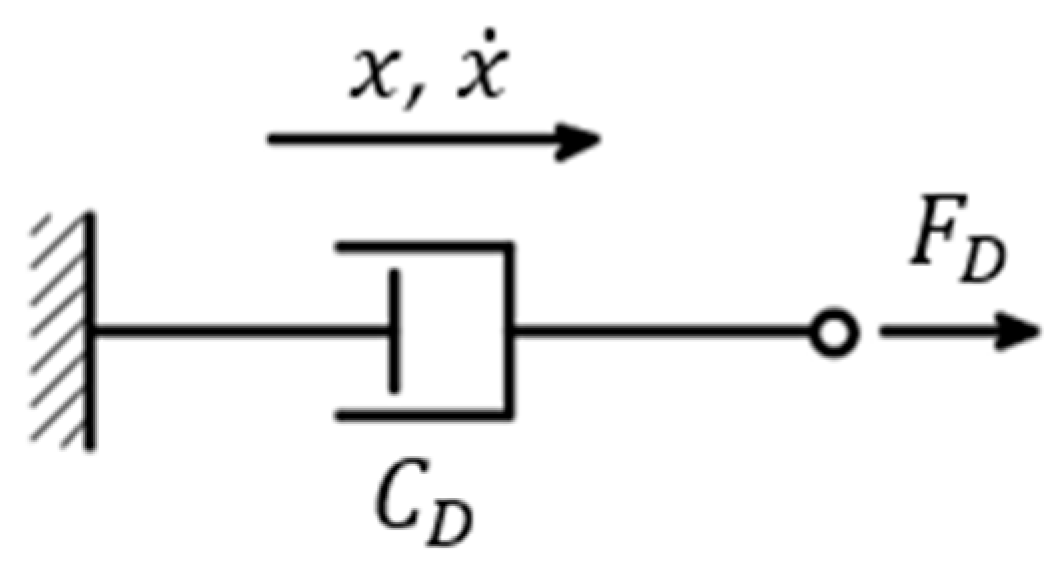
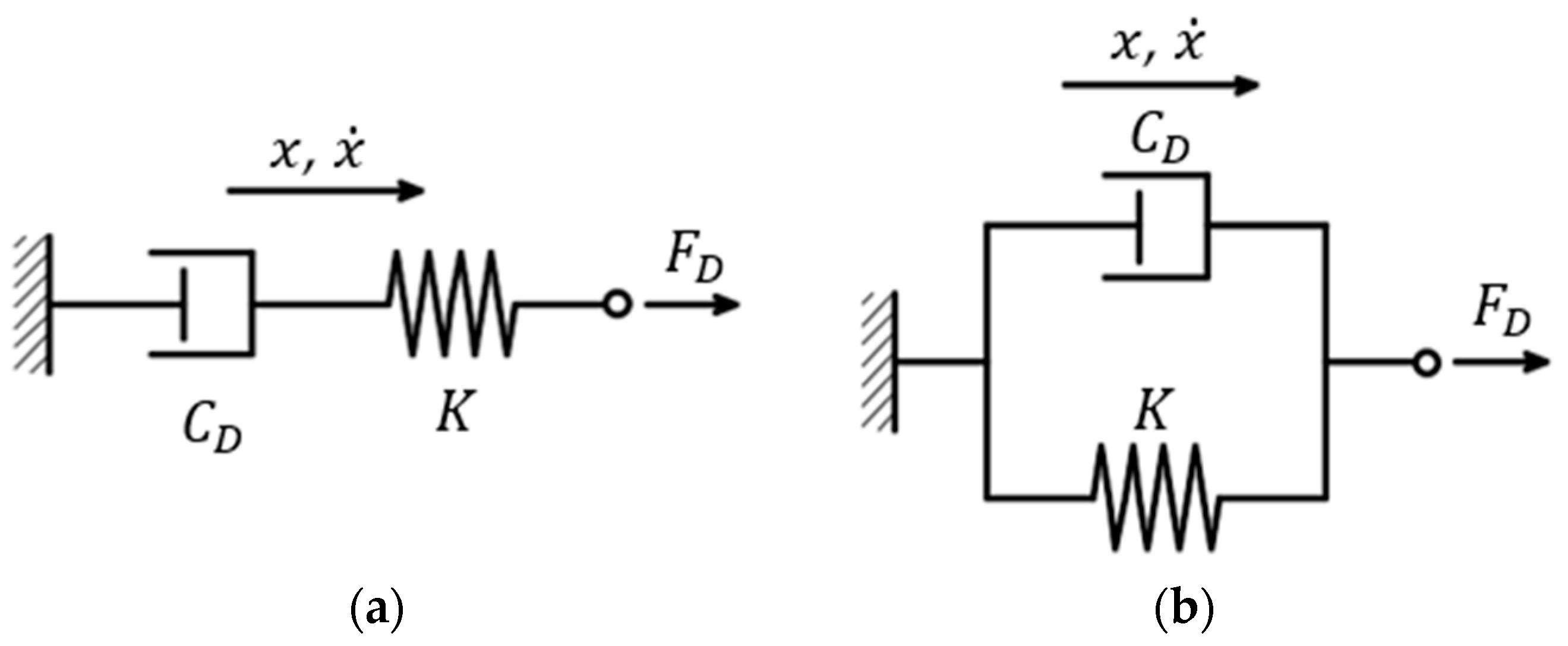






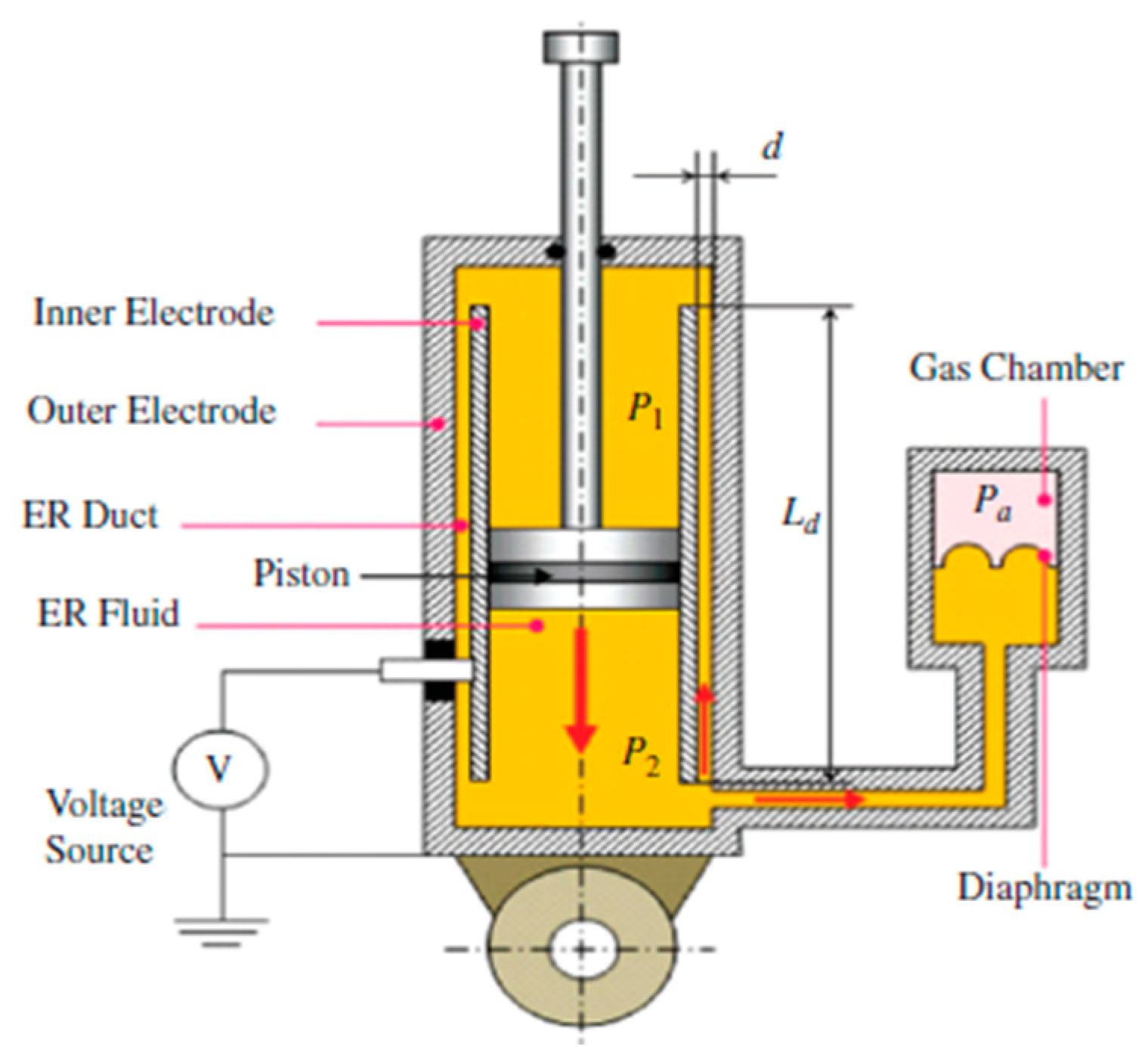
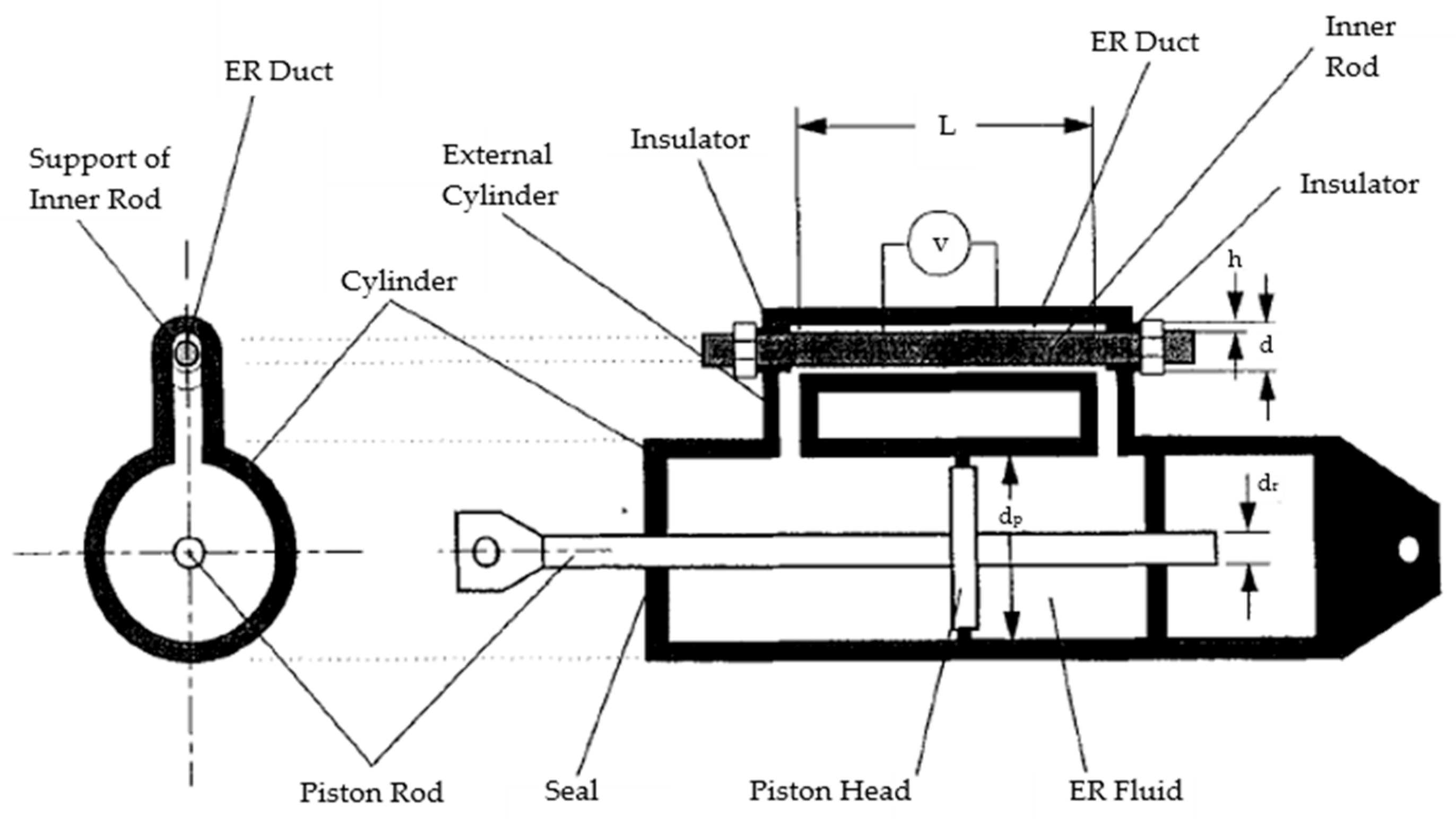


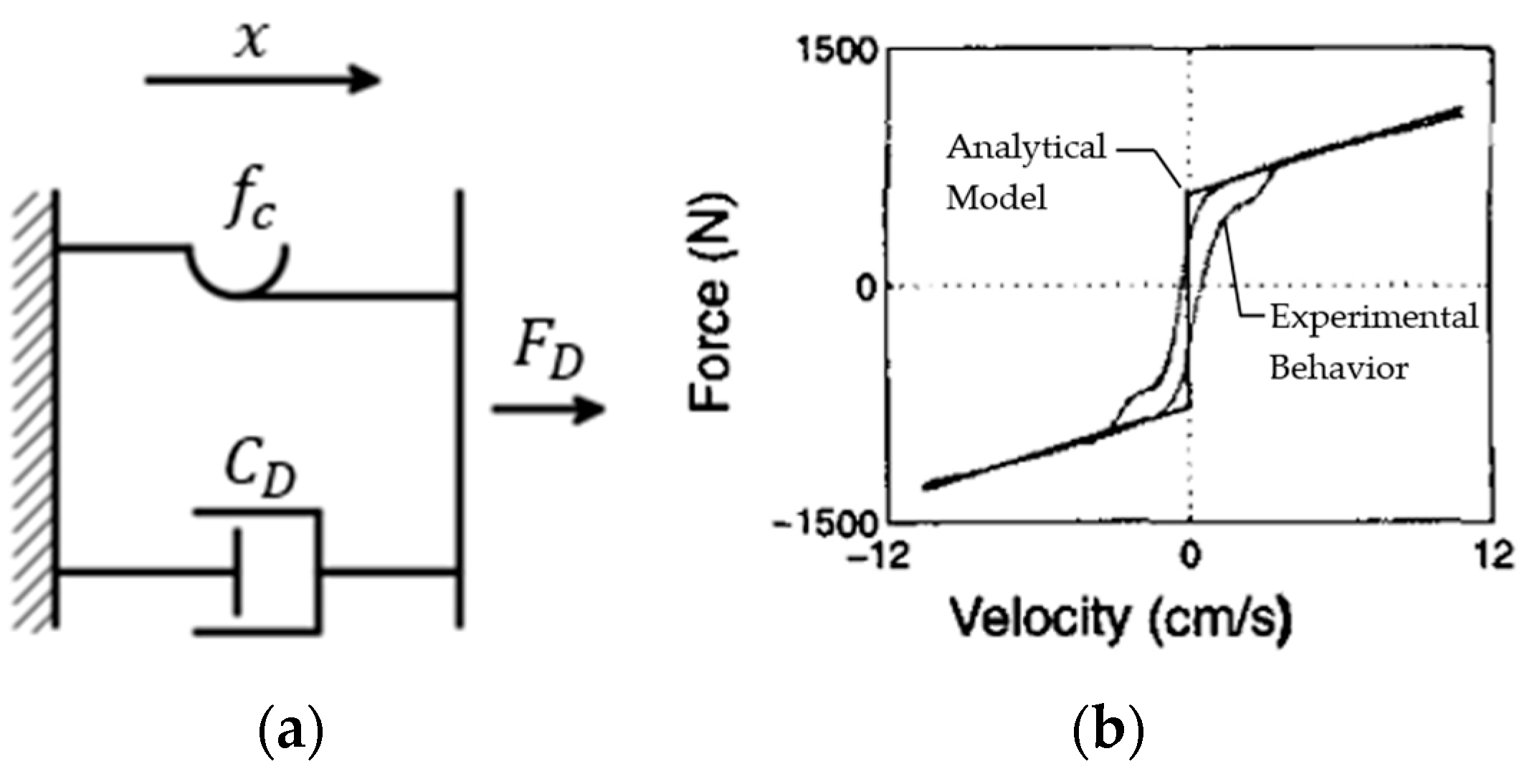

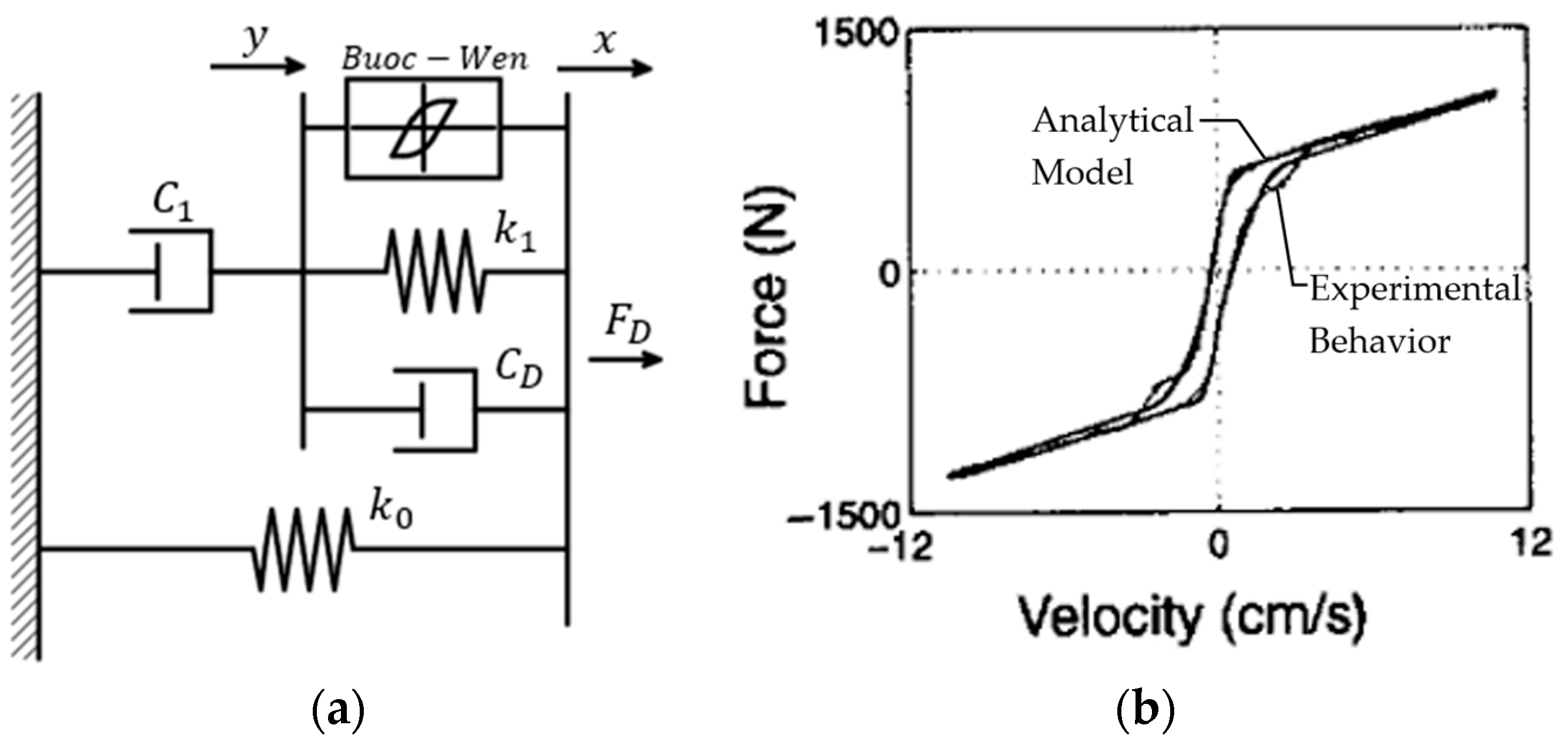

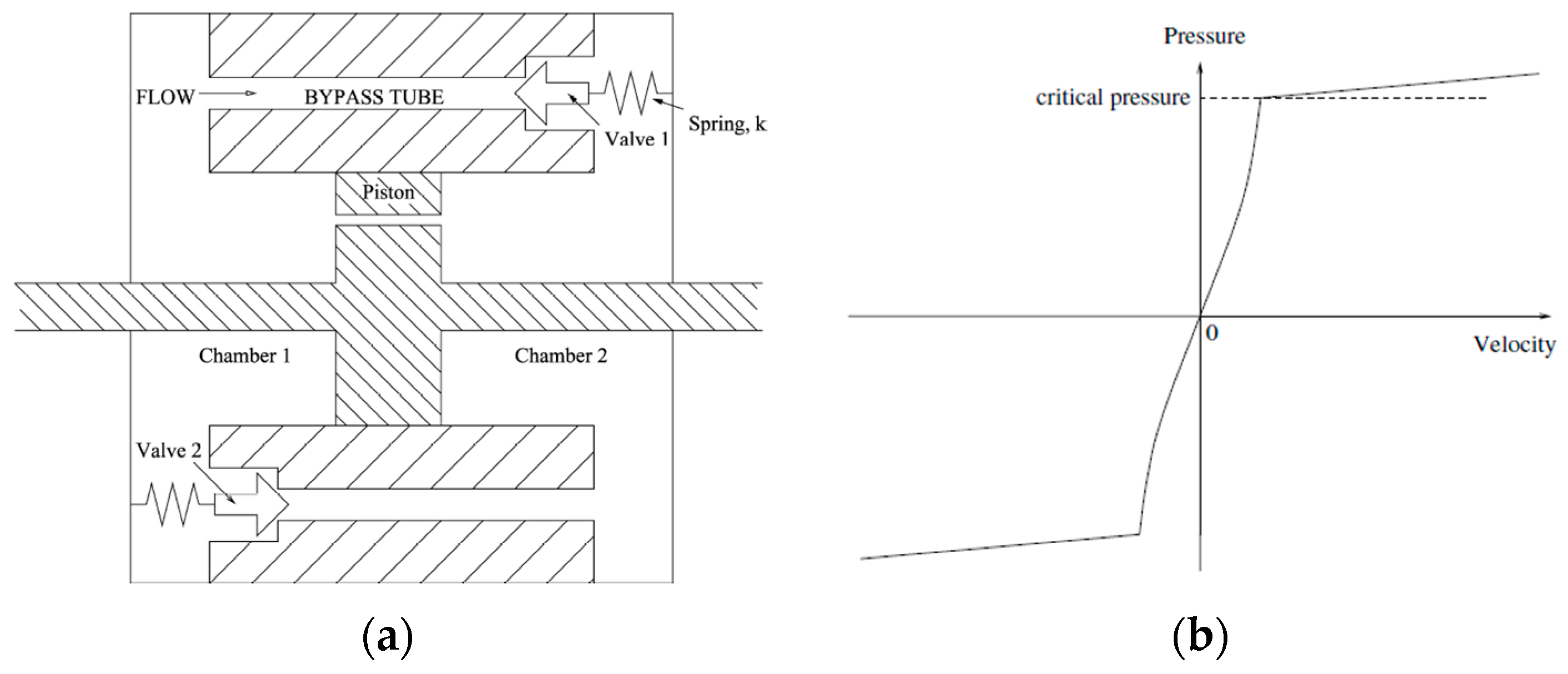

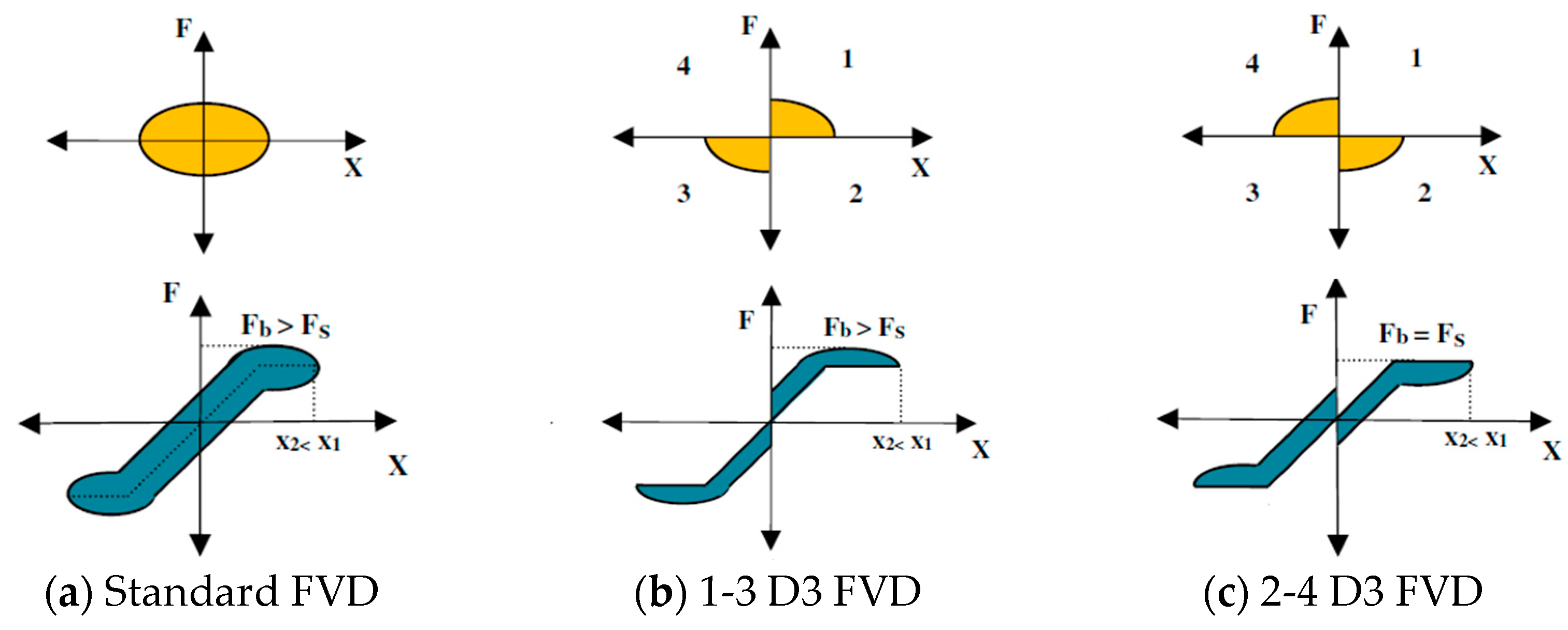

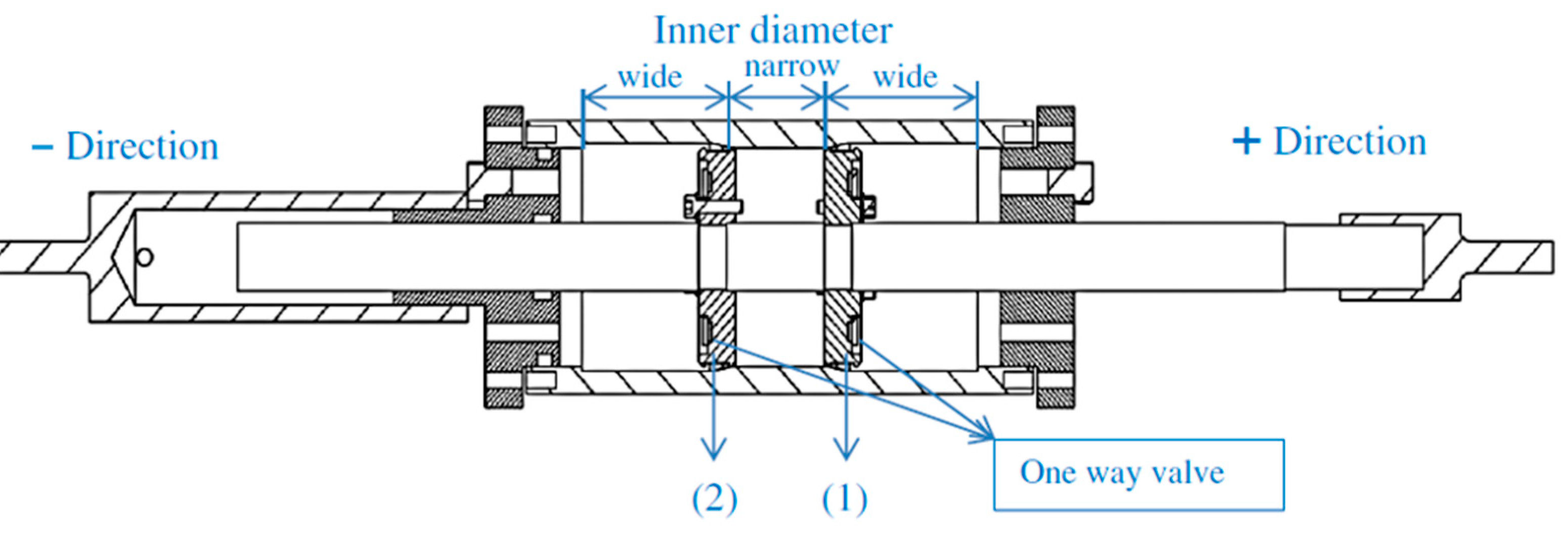

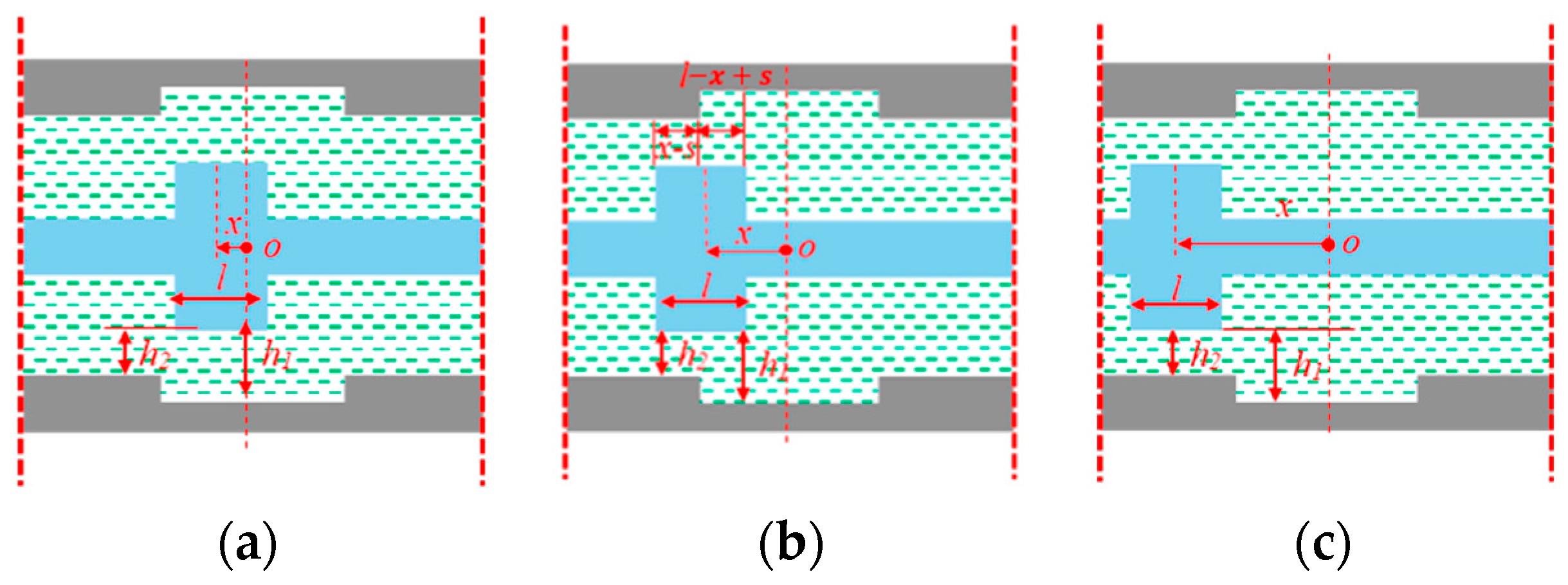

| Property | ER Fluid | MR Fluid |
|---|---|---|
| Yield strength τ | 2–5 kPa | 50–100 kPa |
| Voltage | 2–10 kV | 2–25 V |
| Max. field | 3–5 kV/mm | 150–250 kA/m |
| Viscosity (no field) μ | 0.2–0.3 Pa s | 0.2–0.3 Pa s |
| Density | 1–2 g/cm3 | 3–4 g/cm3 |
| Particle size | 10 nm–10 μm | Several μm |
| Temperature | −25 °C to 125 °C | −40 °C to 150 °C |
Disclaimer/Publisher’s Note: The statements, opinions and data contained in all publications are solely those of the individual author(s) and contributor(s) and not of MDPI and/or the editor(s). MDPI and/or the editor(s) disclaim responsibility for any injury to people or property resulting from any ideas, methods, instructions or products referred to in the content. |
© 2023 by the authors. Licensee MDPI, Basel, Switzerland. This article is an open access article distributed under the terms and conditions of the Creative Commons Attribution (CC BY) license (https://creativecommons.org/licenses/by/4.0/).
Share and Cite
Zoccolini, L.; Bruschi, E.; Cattaneo, S.; Quaglini, V. Current Trends in Fluid Viscous Dampers with Semi-Active and Adaptive Behavior. Appl. Sci. 2023, 13, 10358. https://doi.org/10.3390/app131810358
Zoccolini L, Bruschi E, Cattaneo S, Quaglini V. Current Trends in Fluid Viscous Dampers with Semi-Active and Adaptive Behavior. Applied Sciences. 2023; 13(18):10358. https://doi.org/10.3390/app131810358
Chicago/Turabian StyleZoccolini, Luca, Eleonora Bruschi, Sara Cattaneo, and Virginio Quaglini. 2023. "Current Trends in Fluid Viscous Dampers with Semi-Active and Adaptive Behavior" Applied Sciences 13, no. 18: 10358. https://doi.org/10.3390/app131810358
APA StyleZoccolini, L., Bruschi, E., Cattaneo, S., & Quaglini, V. (2023). Current Trends in Fluid Viscous Dampers with Semi-Active and Adaptive Behavior. Applied Sciences, 13(18), 10358. https://doi.org/10.3390/app131810358










